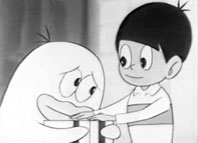 Cartooning team Fujiko Fujio, a joint pseudonym of Hiroshi Fujimoto (1933-1996) and Motoo Abiko (b. 1934), are famous for their children’s comics, having created numerous series throughout their career. Their most famous is arguably Doraemon, which has pretty much taken form as the Japanese Mickey Mouse in terms of merchandising and star power. But before that, their breakout hit was Obake no Q-Taro (“Q-Taro the Ghost”).
Cartooning team Fujiko Fujio, a joint pseudonym of Hiroshi Fujimoto (1933-1996) and Motoo Abiko (b. 1934), are famous for their children’s comics, having created numerous series throughout their career. Their most famous is arguably Doraemon, which has pretty much taken form as the Japanese Mickey Mouse in terms of merchandising and star power. But before that, their breakout hit was Obake no Q-Taro (“Q-Taro the Ghost”).
The comic strip Obake no Q-Taro debuted in Shonen Sunday in 1964, although it moved around to different magazines published by Shogakukan until it ended in 1973. Q-Taro is a chubby ghost who moved in with a Japanese family after a boy named Shota found his egg in the woods. The egg hatched and out came out Q-Taro, who instantly started talking and befriended him. Q-Taro is probably the least-frightening cartoon ghost ever created. His biggest flaw is that he loves to eat, often emptying out whatever food the family has. In addition, he’s afraid of dogs and always runs away whenever he spots one.
Not that Q-Taro doesn’t have any special ghost powers. He has the ability to turn invisible, which can come in handy when needed. In addition, he has the power to fly; Shota often rides on his back whenever he flies around town. A common story element involves a bad guy or someone wanting to take advantage of Q-Taro’s invisibility in order to get a dirty deed done (usually involving theft). Of course, the plan is always foiled by the end of the story.
Other characters include Shota’s parents and his older brother Shinichi. In addition, Q-Taro has two siblings: P-Ko, his younger sister, and Q-jira, his younger brother. In addition, there’s Dorompa, an American ghost who loves to play mischief, and U-Ko, Q-Taro’s temperamental girlfriend. With all these ghosts around, it’s no wonder that nobody is afraid of them. Maybe Casper should consider moving to Japan.
 The first of the three TV series aired August 29, 1965 to June 28, 1967 on TBS (Tokyo Broadcasting System) for 96 episodes. It was the second series produced by the then-new Tokyo Movie (TMS Entertainment) studio, and it was their first major hit. Obake no Q-Taro was the first comedy anime to air in Japan (most anime at the time were superhero or drama), with most episodes being split into two segments, which was unheard of in Japan at the time. This is the program that put TMS on the map in the Japanese TV animation industry, leading them to produce numerous other shows and even doing subcontract animation for American studios, most notably Tiny Toon Adventures. The studio is still in business today.
The first of the three TV series aired August 29, 1965 to June 28, 1967 on TBS (Tokyo Broadcasting System) for 96 episodes. It was the second series produced by the then-new Tokyo Movie (TMS Entertainment) studio, and it was their first major hit. Obake no Q-Taro was the first comedy anime to air in Japan (most anime at the time were superhero or drama), with most episodes being split into two segments, which was unheard of in Japan at the time. This is the program that put TMS on the map in the Japanese TV animation industry, leading them to produce numerous other shows and even doing subcontract animation for American studios, most notably Tiny Toon Adventures. The studio is still in business today.
 TMS brought the show back in 1971, producing a second show called Shin Obake no Q-Taro (New Q-Taro the Ghost). This show aired on Nippon Television from September 1, 1971 to December 27, 1972 for 70 episodes. This show was produced in color; the 1965-67 show was made in black and white. The second series is regarded as the best of the three shows, even though it’s rarely seen these days. The animation was handled by A Production, which always produced fun but limited animation for television.
TMS brought the show back in 1971, producing a second show called Shin Obake no Q-Taro (New Q-Taro the Ghost). This show aired on Nippon Television from September 1, 1971 to December 27, 1972 for 70 episodes. This show was produced in color; the 1965-67 show was made in black and white. The second series is regarded as the best of the three shows, even though it’s rarely seen these days. The animation was handled by A Production, which always produced fun but limited animation for television.
A Production split off from Tokyo Movie in the mid-1970s after a shake-up in the studio management. A Production was renamed Shin-Ei Doga (which literally means “New A Production”). Most of their shows consists of TV versions of Fujiko Fujio comics, notably Doraemon, which is still airing today. Thus it’s no surprise that Shin’Ei revived Q-Taro for the 1980s.
The third series aired April 1, 1985 to March 29, 1987, airing on TV Asahi during weekdays. 510 ten-minute episodes were made altogether. This is the version that’s commonly seen today, still airing in reruns on satellite television and having home video release.
 Hiroshi Fujimoto and Motoo Abiko broke their partnership in 1987. Fujimoto became known as Fujiko F. Fujio, and Abiko became Fujiko Fujio (A). The copyright for their older comics were split, depending on which of the two was felt to be the true creator. For example, Fujimoto is now officially considered to be the true creator of Doraemon and all the rights went to him, while Abiko credited for creating Kaibutsu-kun. However, this never happened with Q-Taro; to this day, both men are regarded as creators of the character.
Hiroshi Fujimoto and Motoo Abiko broke their partnership in 1987. Fujimoto became known as Fujiko F. Fujio, and Abiko became Fujiko Fujio (A). The copyright for their older comics were split, depending on which of the two was felt to be the true creator. For example, Fujimoto is now officially considered to be the true creator of Doraemon and all the rights went to him, while Abiko credited for creating Kaibutsu-kun. However, this never happened with Q-Taro; to this day, both men are regarded as creators of the character.
Nowadays, Q-Taro is overshadowed by Fujiko Fujio’s later works, but the impact it had cannot be understated. It proved that humorous animation can, indeed, succeed in Japanese television.


 Charles Brubaker is a cartoonist originally from Japan. In addition to his work for MAD Magazine and SpongeBob Comics, he also created Ask a Cat for GoComics. You can also follow him on his Tumblr page.
Charles Brubaker is a cartoonist originally from Japan. In addition to his work for MAD Magazine and SpongeBob Comics, he also created Ask a Cat for GoComics. You can also follow him on his Tumblr page.











































It should be noted that O-Taro was voiced by none other than the late Machiko Soga, who is best known to Americans as the evil witch Bandora from the 16th Super Sentai Series, DINOSAUR TASK FORCE ZYURANGER (Toei; 1992), which was the basis for Season 1 of MIGHTY MORPHIN POWER RANGERS (Saban; 1993). Of course, Soga, besides being a prolific voice actress with countless roles I can’t list here, was also no stranger to tokusatsu (Japanese SPFX) TV and film. She is also noted for playing Queen Hedrian, a villainess in two Super Sentai Series, ELECTRONIC TASK FORCE DENJIMAN (Toei; 1980) and SOLAR TASK FORCE SUNVULCAN (Toei; 1981); Hedrian was revived in cyborg form in the latter. Before her passing, her last appearance was in several episodes of the 29th Super Sentai, MAGIC TASK FORCE MAGIRANGER (Toei; 2005), where she played a good character, Heavenly Archsaint Magiel.
Soga also had a charming cameo appearance in SAMARITAN ZATOICHI (Daiei; 1968).
Something is deeply wrong with me. I couldn’t quit listening to the theme song.
Me neither, I love this tune especially!
http://www.youtube.com/watch?v=T8UpoFIAQB8
This one is my second best!
http://www.dailymotion.com/video/xpl5uf_yyyyyqyy-op-full_shortfilms
The ending to the 70’s series is one of those “how to draw” songs!
https://www.youtube.com/watch?v=ja34I73tW08
I heard the theme song before, and it is indeed charming. 🙂
Q-taro actually had a video game for the Japanese Famicom brought over the US by Bandai although like their Dragon Ball and GeGeGe no Kitaro games it was localized into the game Chubby Cherub.
I understand the need to do such things since Q-Taro is completely unknown here but playing as an ugly naked baby with a large head who floats around and eats things is just completely unappealing that I don’t see why they bothered.
It’s just one of those mysteries we’ll never know for certain. I recall many times going to a video store back in the early 90’s and always passing up on Chubby Cherub on the shelf thinking it looked like a stupid game simply going by the silly nude immortal being on the cover. And yet, the thought of a ghost just hatched out of an egg, eats a lot and is constantly afraid of dogs sounds like such a cool idea for a game right there!
A much more interesting video game factoid about Q-Taro: Pac-Man creator Toru Iwatani says that this was the inspiration behind the ghosts in the game.